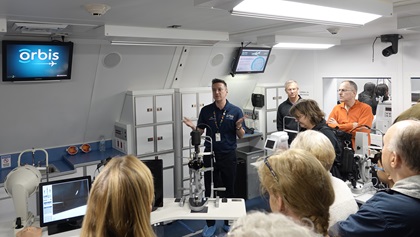Visual approach
AOPA members tour the Orbis Flying Eye Hospital
When Carla Futtrup went to California’s Moffett Federal Airfield to tour the Orbis Flying Eye Hospital on March 2, the event brought back memories of two intense years flying around the world as a mission coordinator for a unique team dedicated to saving sight and teaching doctors how to carry on the crusade.
That chapter ended more than 30 years ago, but Futtrup never lost sight of the fact that the treatments and training she and her peers delivered between 1985 and 1987 still battle sightlessness today. Her brief and unexpected reunion with Orbis International, and with one of the doctors who served when she did, left her amazed at the organization’s growth and the technological advances it brings to the battle against blindness.
“We didn’t have anything on land when I was with the plane,” she said.
It was a rainy Saturday when Futtrup joined several hundred AOPA members for an exclusive tour of the Orbis Flying Eye Hospital at the private Moffett Federal Airfield in Mountain View, California.
There, as the weather cleared, she reconnected with a former Orbis colleague, ophthalmologist James Tearse, who in 1986 spent six months working with other surgeons on the Orbis team and visiting local hospitals to teach.
Orbis Chief pilot Gary Dyson and pilot Cheryl Pitzer, both of FedEx, participated in the day’s event and “were great ambassadors for Orbis and a treat for the groups arriving and waiting their turn to make the tour,” said AOPA Media Representative Tom Linton.
Tearse, of Mountain View, reminisced to Linton that he originally expected the organization’s medical mission to last just a few years. He was “stunned” to learn how far Orbis International had come, having now served 23 million patients in 92 countries and trained 325,000 medical professionals. In 2017 alone, Orbis International undertook 66 projects in 18 countries in its quest to eradicate blindness—an especially devastating but preventable affliction in developing countries, as Bruce Johnson, the Orbis director of aircraft operations, told AOPA.

Between 2013 and 2017, the professionals on the airplane and in the Orbis clinics performed more than 15.7 million eye exams and screenings and approximately 400,000 eye surgeries and laser treatments, a quarter of them on children, as AOPA reported on Feb. 6.
Futtrup recalled the frenetic pace of the logistical and administrative efforts that supported the Orbis missions—a job she described as “managing everything that wasn’t doctors and nurses.” That roster of responsibilities included meeting visiting doctors and dealing with “publicity and news conferences and tours, and people and dignitaries coming and going.”
After she joining up in Istanbul, Turkey, Futtrup's Orbis travels took her to Iraq, Jordan, Malta, and Egypt, and across the Atlantic Ocean to the Caribbean, Central America, and South America. In the pre-digital age, international communication was over the telex network.
“In the old days we might have a classroom in the airport. We thought we were really high-tech when we got a copier,” she said, adding, “I would spend hours trying to get stuff copied.”
Not a technology devotee in general, Futtrup—who went on to become an oncology nurse following her Orbis stint, retiring after 25 years—admitted being dazzled by Orbis’s capabilities.
“The technology is amazing,” she said. “Now they can set up simulations for the surgeries that are computerized and can broadcast around the world on the internet.
“They can do surgery in Venezuela and someone watching in China can ask a question. They can talk back and forth across the world, which is pretty amazing, I think.”
When explaining the Orbis mission, Futtrup said, she takes pains to differentiate its education-based model from the strategy of medical groups that provide urgently needed on-scene medical services in a disaster-struck or needy place, and then move on.
“Orbis wants to teach the doctors there, the nurses, the assistants, and bring awareness to blindness,” she said. “And then when we leave, they can continue to take care of people.”





